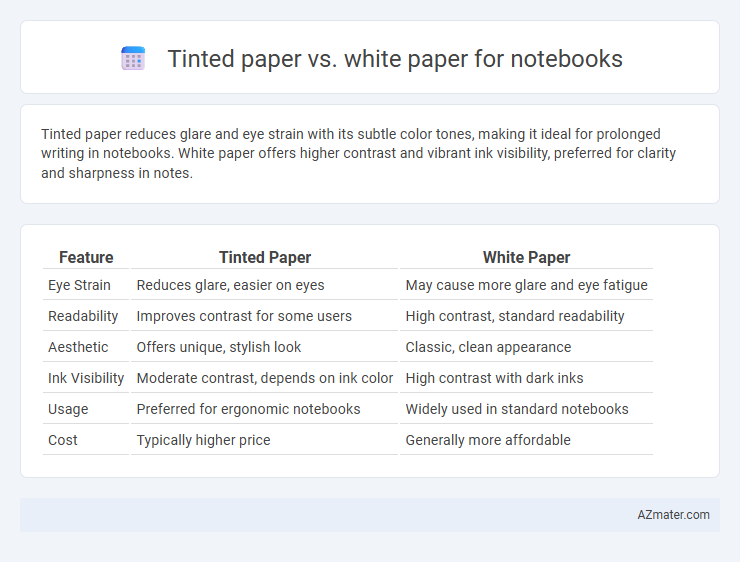Tinted paper reduces glare and eye strain with its subtle color tones, making it ideal for prolonged writing in notebooks. White paper offers higher contrast and vibrant ink visibility, preferred for clarity and sharpness in notes.
Table of Comparison
| Feature | Tinted Paper | White Paper |
|---|---|---|
| Eye Strain | Reduces glare, easier on eyes | May cause more glare and eye fatigue |
| Readability | Improves contrast for some users | High contrast, standard readability |
| Aesthetic | Offers unique, stylish look | Classic, clean appearance |
| Ink Visibility | Moderate contrast, depends on ink color | High contrast with dark inks |
| Usage | Preferred for ergonomic notebooks | Widely used in standard notebooks |
| Cost | Typically higher price | Generally more affordable |
Introduction: Tinted Paper vs White Paper in Notebooks
Tinted paper in notebooks reduces glare and eye strain, making it ideal for prolonged writing or reading sessions, especially under bright lighting. White paper offers high contrast and clarity, enhancing the visibility of ink colors and fine details for precise note-taking. Choosing between tinted and white paper depends on the user's preference for comfort versus visual sharpness during use.
Visual Appeal and Aesthetics
Tinted paper enhances visual appeal by reducing glare and offering a softer, more inviting tone compared to stark white paper, making handwritten notes easier on the eyes. The subtle hues, such as cream or pastel shades, add a stylish and unique aesthetic that can elevate the overall notebook experience. White paper provides a clean, crisp background that works well for high contrast writing and vibrant ink colors, but may appear less warm or personalized than tinted options.
Writing Comfort and Eye Strain
Tinted paper in notebooks reduces glare and blue light exposure, which significantly enhances writing comfort and minimizes eye strain during prolonged use. Its softer contrast compared to stark white paper decreases visual fatigue, making it ideal for individuals with light sensitivity or those who write for extended periods. White paper, while traditional, often causes more eye fatigue due to high brightness and sharp reflections under artificial lighting conditions.
Suitability for Different Writing Tools
Tinted paper in notebooks reduces glare and eye strain, making it ideal for gel pens and ballpoint pens that often produce vibrant and smooth lines, while the colored background enhances readability. White paper offers a neutral surface, best suited for pencils and ink pens that require clear contrast for detailed sketches or fine handwriting. Both paper types vary in thickness and texture, affecting ink absorption and preventing bleed-through depending on the writing instrument used.
Impact on Readability and Note Organization
Tinted paper in notebooks reduces glare and eye strain, enhancing readability for extended writing sessions, especially under bright lighting conditions. White paper offers higher contrast with ink, improving text clarity and making it easier to distinguish notes and annotations. For note organization, tinted paper can subtly segment content visually, while white paper supports clear demarcation through color-coded pens and markers.
Psychological and Cognitive Effects
Tinted paper in notebooks can reduce visual stress and eye strain, enhancing reading comfort and focus, especially for individuals with dyslexia or light sensitivity. White paper, while standard and versatile, may cause glare that can lead to faster visual fatigue and decreased cognitive performance in prolonged writing or reading sessions. Choosing tinted paper supports improved concentration and information retention by mitigating sensory overload and promoting a calmer visual environment.
Environmental Considerations
Tinted paper for notebooks often requires fewer bleaching chemicals compared to white paper, reducing environmental pollutants and chemical waste. However, tinted paper production may involve dyes that need careful management to prevent ecological contamination. Choosing recycled tinted paper or white paper from sustainably managed forests further enhances environmental benefits by minimizing deforestation and energy consumption.
Cost and Availability
Tinted paper for notebooks generally costs more due to specialized dyes and limited production runs, while white paper remains widely available and more affordable as a standard option. Availability of tinted paper is often restricted to specialty suppliers or specific markets, whereas white paper is produced in large quantities globally, ensuring consistent supply and lower prices. Businesses and consumers seeking cost-effective notebook solutions typically prefer white paper for its economical pricing and broad accessibility.
Best Uses for Tinted Paper Notebooks
Tinted paper notebooks are ideal for reducing eye strain during prolonged writing or reading sessions, making them a preferred choice for students, artists, and professionals who engage in extensive note-taking or sketching. The subtle color contrast improves focus and reduces glare, which enhances visual comfort compared to standard white paper notebooks. Tinted paper is particularly effective in low-light environments or for individuals with light sensitivity, offering a practical alternative that supports productivity and creativity.
Best Uses for White Paper Notebooks
White paper notebooks provide a crisp, clear background ideal for precise note-taking, sketching, and printing, making them preferred in academic and professional settings. Their high contrast enhances readability and makes colors and ink stand out vividly, which benefits detailed diagrams or annotations. White paper is also versatile for a range of pen types and ink colors without bleed-through or distortion, supporting varied creative and organizational tasks.

Infographic: Tinted paper vs White paper for Notebook
 azmater.com
azmater.com